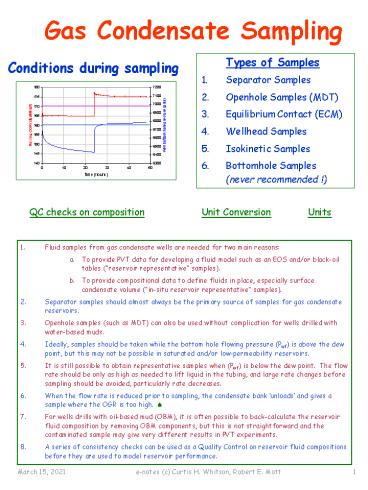Gas Condensate Sampling - PowerPoint PPT Presentation
Title:
Gas Condensate Sampling
Description:
Gas Condensate Sampling Types of Samples Separator Samples Openhole Samples (MDT) Equilibrium Contact (ECM) Wellhead Samples Isokinetic Samples Bottomhole Samples – PowerPoint PPT presentation
Number of Views:243
Avg rating:3.0/5.0
Title: Gas Condensate Sampling
1
Gas Condensate Sampling
- Types of Samples
- Separator Samples
- Openhole Samples (MDT)
- Equilibrium Contact (ECM)
- Wellhead Samples
- Isokinetic Samples
- Bottomhole Samples
- (never recommended !)
Conditions during sampling
Unit Conversion
Units
QC checks on composition
- Fluid samples from gas condensate wells are
needed for two main reasons - To provide PVT data for developing a fluid model
such as an EOS and/or black-oil tables
(reservoir representative samples). - To provide compositional data to define fluids in
place, especially surface condensate volume
(in-situ reservoir representative samples). - Separator samples should almost always be the
primary source of samples for gas condensate
reservoirs. - Openhole samples (such as MDT) can also be used
without complication for wells drilled with
water-based muds. - Ideally, samples should be taken while the bottom
hole flowing pressure (Pwf) is above the dew
point, but this may not be possible in saturated
and/or low-permeability reservoirs. - It is still possible to obtain representative
samples when (Pwf) is below the dew point. The
flow rate should be only as high as needed to
lift liquid in the tubing, and large rate changes
before sampling should be avoided, particularly
rate decreases. - When the flow rate is reduced prior to sampling,
the condensate bank unloads and gives a sample
where the OGR is too high. ? - For wells drills with oil-based mud (OBM), it is
often possible to back-calculate the reservoir
fluid composition by removing OBM components, but
this is not straightforward and the contaminated
sample may give very different results in PVT
experiments. - A series of consistency checks can be used as a
Quality Control on reservoir fluid compositions
before they are used to model reservoir
performance.
2
- References
- Sampling and PVT Notes
- API Recommended Practice
- SPE Phase Behavior Monograph Ch 3
- SPE Phase Behavior Monograph Ch 5
- Sampling Gas Condensate wells (McCain)
- Accurate In Situ Compositions in Petroleum
Reservoirs
- Examples
- 1D simulation model for studying impact of rate
changes on samples
Notes












![Lecture note : Gas chromatography [1] ????????? PowerPoint PPT Presentation](https://s3.amazonaws.com/images.powershow.com/6692254.th0.jpg?_=20150604093)
![Lecture note : Gas chromatography [2] ????????? ??? PowerPoint PPT Presentation](https://s3.amazonaws.com/images.powershow.com/6741367.th0.jpg?_=20150612015)

















